-
San Diego sheriff: Migrants did not try to forcefully stop school bus - August 31, 2024
-
One stabbed, another injured in altercation on L.A. Metro bus - August 31, 2024
-
Trump Judge Has ‘Two Options’ as Future of Case Unclear: Analyst - August 31, 2024
-
What to Know About Putin’s Planned Visit to Mongolia Amid ICC Arrest Warrant - August 31, 2024
-
Buying sex from a minor could be a felony under bill headed to Newsom - August 31, 2024
-
Democrat Lawmaker Switches Party to Become Republican - August 31, 2024
-
Misdated Mail-In Ballots Should Still Count, Pennsylvania Court Rules - August 31, 2024
-
Cause and manner of death determined for Lucy-Bleu Knight - August 31, 2024
-
NASCAR Craftsman Truck Series Announces Return To Iconic Circuit In 2025 - August 31, 2024
-
At Pennsylvania Rally, Trump Tries to Explain Arlington Cemetery Clash - August 31, 2024
Whimsical scrap sculptures could be permanently removed in Mar Vista
Artist Lori “Welderado” Powers may soon have her collection of about 29 scrap sculptures scattered in her frontyard. It would mark the full circle of a seven-year project: welding recycled materials and donated trinkets into whimsical sculptures containing uplifting messages.
Since 2017, the brightly colored, smiling characters have greeted drivers and pedestrians along Palms Boulevard and Marco Place in Mar Vista, secured 10 feet high on city utility poles.
“The whole point is to have a character looking at the traffic, to slow down drivers and make them ease through the neighborhood,” Powers said.
Now the Los Angeles Department of Water and Power is looking to take down the artwork, which officials say is hazardous to crew workers and pedestrians.
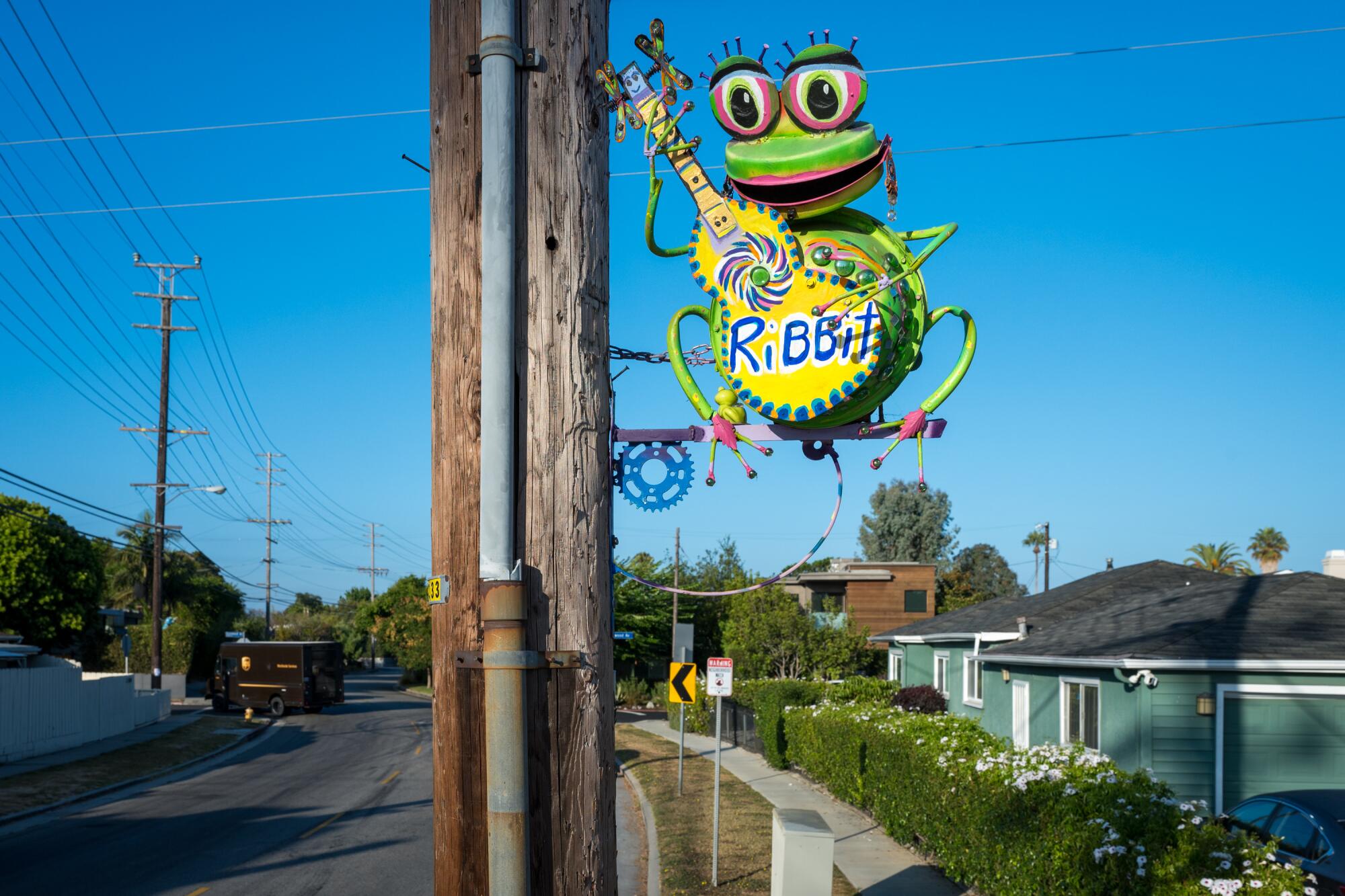
Sculptures by artist Lori Powers that are affixed to utility poles on Palms Boulevard in Mar Vista.
(Michael Owen Baker/For The Times)
Some neighbors, like former L.A. City Councilmember Ruth Galanter, have expressed frustration over the possible removal and relocation of the art pieces — which she says bring her happiness.
“Why are they in such a hurry? They left these things in place for seven years,” said Galanter, who represented the area from 1987 to 2003. “Suddenly it has to be gone like today.”
Powers first began installing her sculptures in 2017 late at night to remain anonymous. She would later wear a mustache and wig purchased from Amazon to appear unrecognizable while reinstalling the characters. She formally introduced herself to the community as the artist during the COVID-19 pandemic.
“That was kinda fun for me,” Powers said. “It was almost like Banksy, you don’t know who it is. It just got the whole community talking.”
She gives each piece a name and personality: Bike Dude is an 80-year-old toolbox, with two bike handles and a seat as its hair and nose. Bird Jam has a Cadillac hubcap and nitrogen tank as its body, with wings attached to a miniature banjo. Ribbit is a frog musician made of two metal bowls with an omelet maker as its face.
“I’m also a three-on-three basketball player,” she said. “I take my gold medals and I put them on all the characters. I disguise them there. It’s like a message of friendship, love and teamwork. So, when people look at them, all that energy beams down.”
Powers takes down the sculptures once a year, giving them a fresh coat of paint and attaching new features depending on their wear and tear. The surgical process is completed in her backyard workshop.
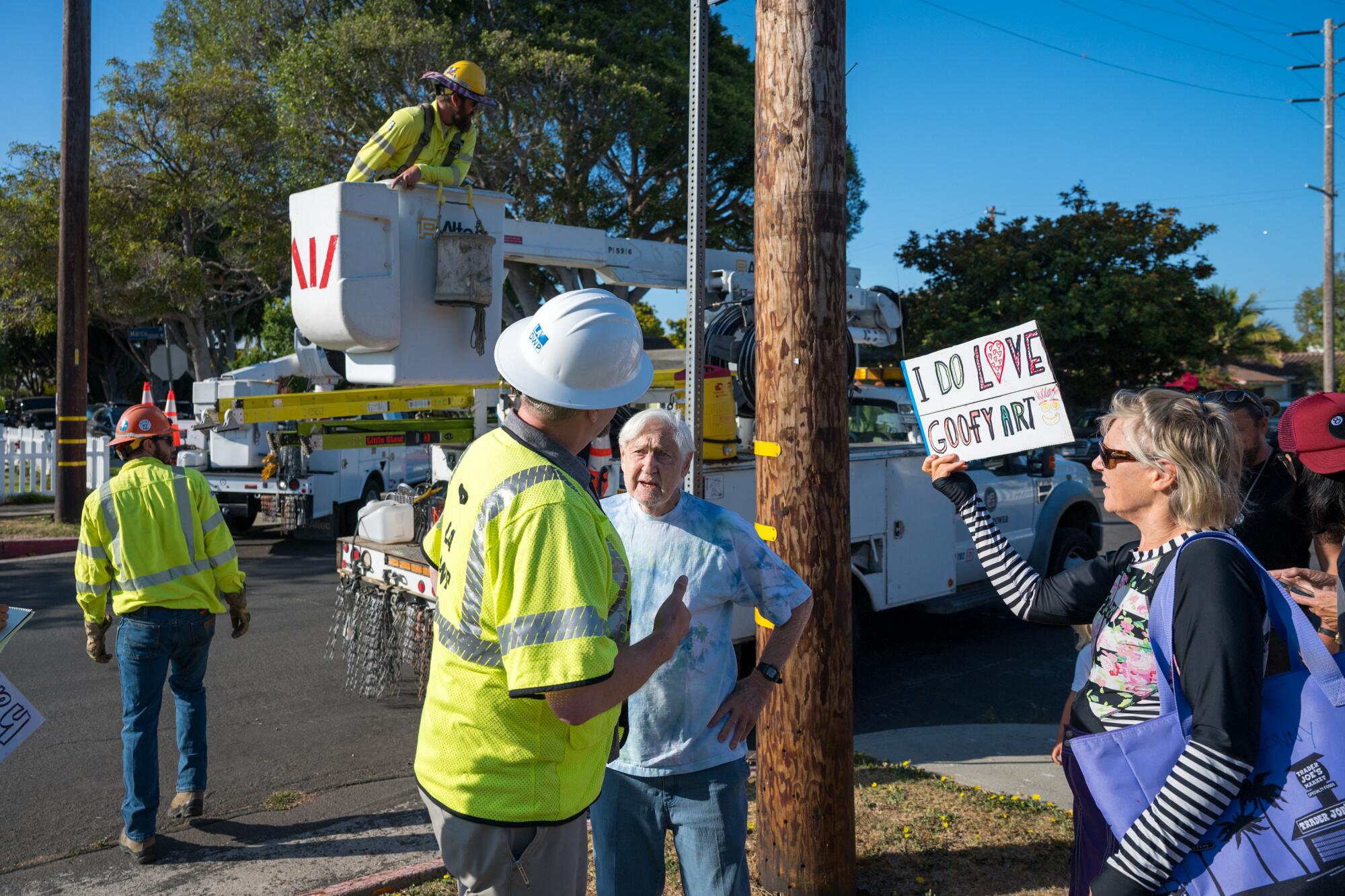
Mar Vista resident Paul Von Blum, center, questions DWP supervisor Dan Grout about the removal of a sculpture by Lori Powers that was affixed to a utility pole.
(Michael Owen Baker/For The Times)
“Now that I took Beezy down, I’ll repaint the bees up here and add a little sparkle before it goes back up on the pole,” she said.
About two weeks ago, Powers received a notice from the DWP that her artwork would be removed from the power poles Tuesday. She says the agency has removed individual pieces before.
“Every now and then, a DWP guy would come and say somebody complained about this character, so they would take it down,” she said. “He would take it down, then I would put it back up.”
Powers says she developed a mutual understanding with city workers — one volunteering to reinstall a sculpture, “Big Hugs,” made in part from an outdoor light fixture found in the rubble of a burned home in Malibu.
But now the removal could be permanent.
Galanter says she received a memo from the DWP sent to Councilwoman Traci Park’s office, explaining that city attorneys did not consider the sculptures to be art.
Paul Von Blum, senior lecturer at UCLA, says he disagrees.
“I tell my students, especially when I’m teaching art history, about her work,” said Von Blum, who has written books on art, culture and politics. “I do a whole course on social and political themes, and I start with some very contemporary things like Lori’s work. It’s a valuable thing. The placement makes sense.”
Von Blum says Powers’ work contributes to the Los Angeles’ art scene, with similar style as street artists from the Watts Towers Arts Center.
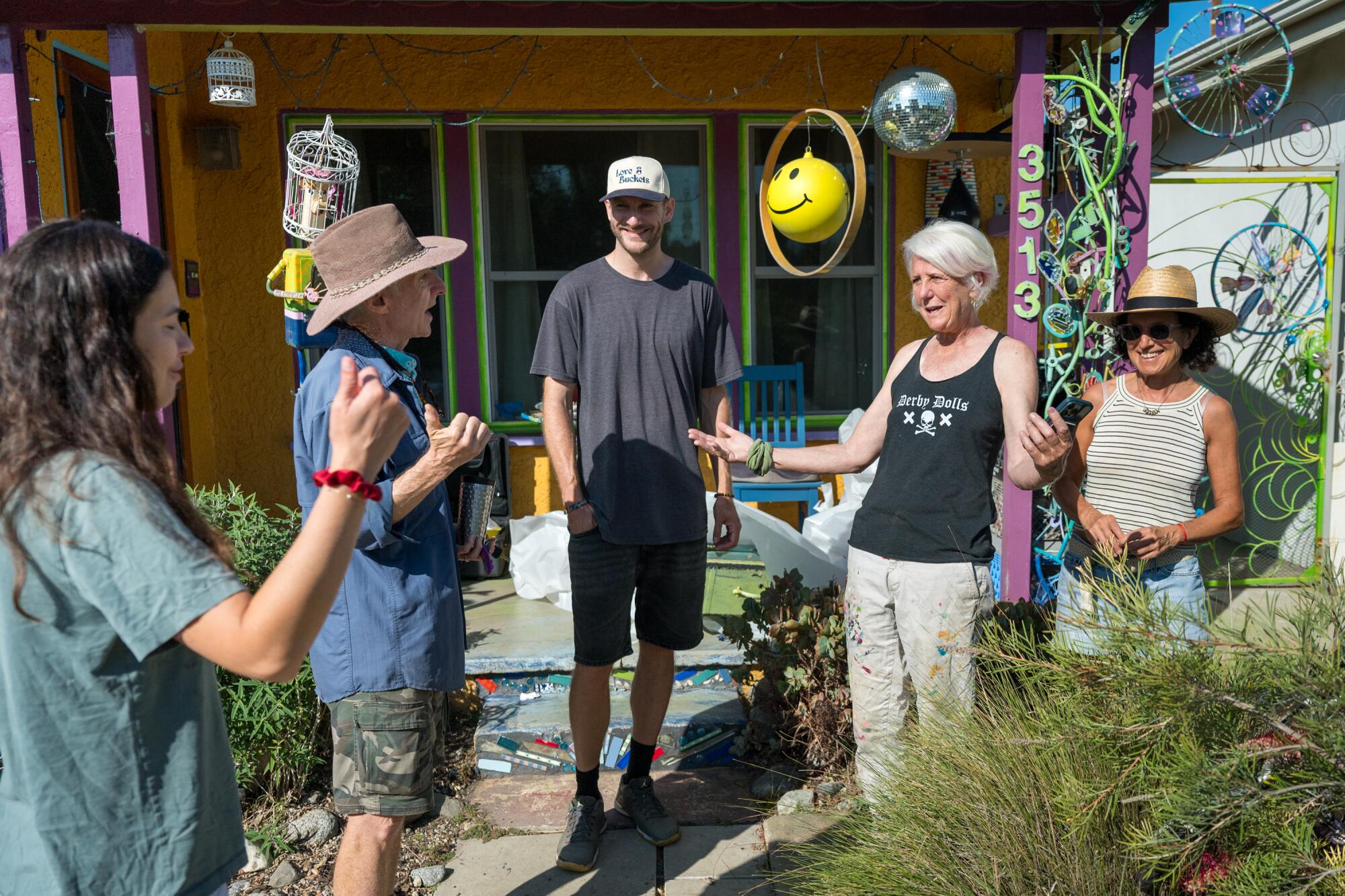
Lori Powers, second from right, talks with supportive Mar Vista residents at her home.
(Michael Owen Baker/For The Times)
“They took trash, and they turned it into these extraordinary works. Some of them were exuberant, they did installations, assemblages and that really created it,” he said. “This is obviously not as grand as that, but it’s the model. It adds to the aesthetic dimension, and aesthetics are a part of our lives.”
Galanter says the problem comes down to the DWP’s rigid bureaucracy.
“It needs to be a giant bureaucracy in order to deliver water and power. I don’t quarrel with that, but giant bureaucracies don’t have much flexibility,” Galanter said. “Putting anything on a power pole is probably illegal, but if the DWP workers themselves were happy to put the things back up, they can’t be that much of a hazard.”
A spokesperson from the DWP said power poles are required to be clear from all obstructions according to General Order 95 of the California Public Utilities Commission.
“No permit requesting permission to install the pieces on these poles was requested, nor would a permit have been issued. For the safety of the public and our crews, the installations must be removed,” said the DWP via email. “We have been in direct contact with the artist since and are working with her to coordinate their removal and return of the installations.”
Powers says she installed the art far below the electrical lines to avoid any hazards.
“I do safety design because I wanted them to last,” she said. “And I’m a mother. So, mothers make sure everything is extra safe.”
An email chain rallying support to keep the sculptures in place began to circulate days before the scheduled arrival of the DWP workers. Powers says some of the messages brought her to tears.
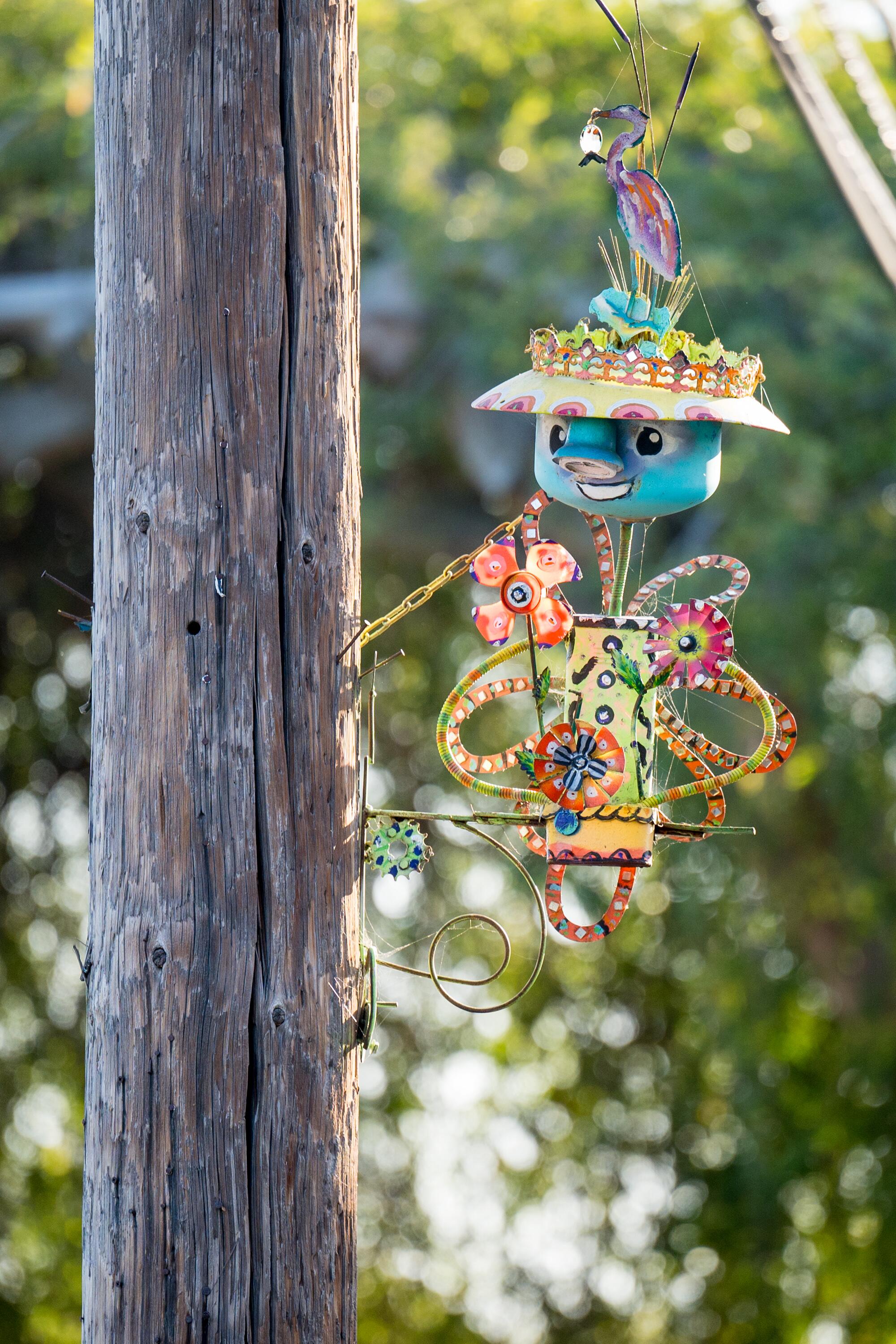
Another sculpture by Lori Powers.
(Michael Owen Baker/For The Times)
“Each piece is assembled from would-be-trash, and is transformed into a sweet, wacky, colorful sculpture waving and wishing passers-by a loving and positive message,” resident Beth Edelstein wrote to Councilwoman Park’s office via email. “Why would anyone want to get rid of happiness and positive messages?”
Staff members from Park’s office said the removal would be postponed until the councilwoman returned from a work trip.
“My office is working closely with the artist and DWP to find a solution that honors the community’s wishes,” Park said in an email statement. “In the meantime, DWP won’t move forward with their planned removal, giving us more time to explore our available options.”
However, DWP crews appeared Tuesday morning, removing two pieces. A group of neighbors and supporters prevented workers from completing the takedown.
DWP supervisor Dan Grout said he got no word of Park’s push to postpone the removal.
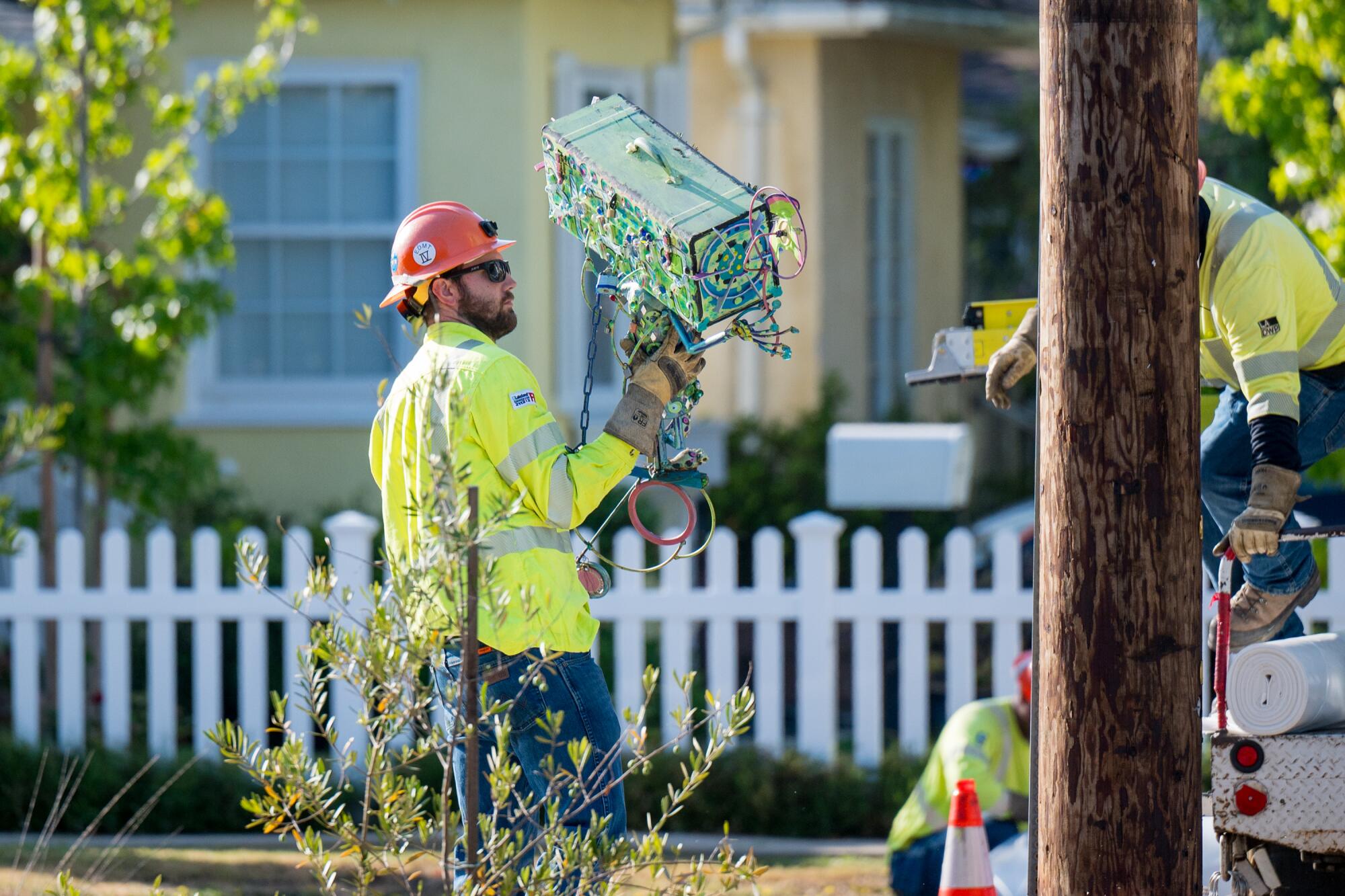
A DWP worker removes a sculpture by Lori Powers that was affixed to a utility pole in Mar Vista.
(Michael Owen Baker/For The Times)
“We had to come down to make the attempt,” Grout said.
Powers says she wants to keep the sculptures in place, potentially creating a walking tour to Venice’s Mosaic Tile House, co-owned by her friend Gonzalo Duran, who taught her how to weld. The tour could potentially be a destination, boosting local foot traffic and business, she said.
“We have soccer and the Olympics coming up, and L.A. is supposed to be this place where there is art and music,” she said. “So, between the characters and getting a bunch more murals done in the neighborhood, this could be the place to go.”
Source link













